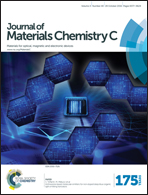Effect of substituents in a series of carbazole-based host-materials toward high-efficiency carbene-based blue OLEDs†
Abstract
In this study, we systematically investigated the effect of substituents in a series of carbazole-based host material toward blue OLED performances using a carbene-based phosphorescent emitter, mer-tris(N-dibenzofuranyl-N′-methylimidazole)iridium(III) [Ir(dbfmi)]. As a host material, we used three derivatives of 9-phenylcarbazole, each containing different substituents: triphenylmethane for 9-phenyl-3,6-ditrityl-9H-carbazole (CCz), triphenylsilane for 9-phenyl-3,6-bis(triphenylsilyl)-9H-carbazole (SiCz) and diphenylphosphine oxide for 3,6-bis(diphenylphosphoryl)-9-phenylcarbazole (PO9). All the host materials showed high triplet energy (ET) of 2.99 eV, which is 0.1 eV higher than that of Ir(dbfmi) (ET = 2.89 eV). Although these host materials can be expected to confine all the molecular triplet excitons of Ir(dbfmi), realizing a high photoluminescent quantum yield (ηPL) with potential use in high-performance blue devices, co-deposited films of host:Ir(dbfmi) exhibited large differences in ηPLs of 54–75%. More surprisingly, the films also showed device performances with external quantum efficiencies (ηext,max) of 9.5–21%, depending on the substituents. These large efficiency losses are most likely caused by host–host aggregation, and inferior carrier balance of holes and electrons in the devices. However, by taking advantages of the different optelectronic properties of the carbazole derivatives, we successfully realized a blue OLED with a high power efficiency of 21.7 lm W−1, a low driving voltage of 3.40 V, and the Commission Internationale de l'Eclairage chromaticity coordinates (CIE) of (0.15, 0.18) at 100 cd m−2. These performances are among the highest in Ir(dbfmi)-based devices so far reported.



 Please wait while we load your content...
Please wait while we load your content...